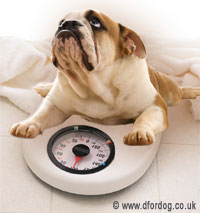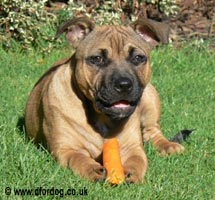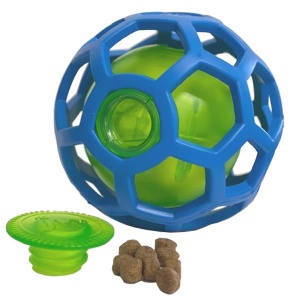Dog Weight and Obesity
Millions of UK cats and dogs are suffering from obesity. Obesity is thought to be a serious problem for over a third of the UK’s combined cat and dog population.

Discounting genuine medical conditions, obesity is caused quite simply by overfeeding, inappropriate feeding and/or a lack of exercise. Animals, just like us, become overweight if they consume more calories than they require.
The problem is not only the overfeeding of pet food. The current trend for treating pets like members of the family means that many owners give their pets the wrong types of food as well as too much food. Owners need to be aware that food intended for humans can be high in calories and have a detrimental effect on their pet’s health. Dogs can be greedy and they don’t differentiate between healthy and non-healthy foods. They rely on their owners to feed them correctly.
Is my dog overweight?
The ideal body weight for any animal varies dramatically according to breed, sex and age. The Pet Food Manufacturers Association www.pfma.org.uk offers the following ways to assess whether your animal is overweight:
Thin – ribs easily felt, backbones and hip bones visible
Underweight – ribs easily felt, waist very obvious
Ideal – ribs can just be felt with no excess fat, tummy tucked up when viewed from side, waist narrows after ribs
Overweight - ribs can be felt but with excess fat, waist can be seen but not easily, tummy only just tucked up
Obese - ribs not easily felt, waist almost invisible, tummy may be sagging
Hungry all the time
If your pet is overweight and seems hungry and thirsty all the time, it is important to visit your vet and rule out any medical conditions first. A number of medical conditions can cause increased appetite, such as diabetes, Cushing’s disease and exocrine pancreatic insufficiency.

If your dog has been checked out by the vet and is otherwise healthy, it may just be that your dog has more of an appetite than most. A change of diet is one option. Feeding a high fibre diet helps the dog to feel fuller. If the dog is a scavenger then it might be habit more than hunger that drives this. Distraction from the scavenging can help or the use of a basket muzzle when walking in areas where they might find contraband.
Why weight matters
Obesity puts a strain on the joints which, combined with reduced exercise, can lead to arthritis. An overweight dog can also experience stress on internal organs and all body structures, can be at risk if undergoing surgery, is at increased risk of suffering from diabetes, heart and kidney problems, heat intolerance, and has a reduced life expectancy.
Maintaining a good weight
Genetics, age, appetite, activity level, reproductive status and the gender of a dog can influence how likely they are to become obese.
If your dog becomes less active due to age or other factors, reduce the amount of food they are given. For example, many bitches require less food after being spayed.
If your dog is fed treats in the day, make sure their meal time portions are reduced accordingly (no more than 15% of their food intake should be treats though). Consider substituting food treats for praise, strokes, games, a favourite toy or a nice massage. You dog will appreciate these things and your bond with your dog will improve. You could also substitute high calorie treats for healthy options such as raw carrots or rawhide chews.
If you feed a commercial pet food, make sure you are feeding a food that is suitable for your dog’s requirements. Many companies make food especially for puppies, adults and senior dogs. Many pet foods also offer a ‘light’ option and some distinguish between working and non-working dogs.
Choosing the right dog food
The starting point of any fit and healthy pet is a good quality dog food. Don't necessarily believe what you see on TV adverts. Some of the most popular and easily available pet foods are shockingly bad when you look at the nutritional value they provide.
Choosing a good food brand amongst the vast array available these days can seem daunting but we recently discovered a great resource to help. Using the All About Dog Food website you can quickly and easily compare the quality and price of various dog food brands.
Even if you have been feeding a certain brand for years, you may be shocked at what you find out. The consequences of feeding your dog a poor quality food will impact all aspects of your dog's health and well-being, not just their waistline.
How much to feed?
Once you have selected the best type of food for your dog, start by feeding the amount recommended by the manufacturer’s feeding guide but keep an eye on your pet’s weight and alter their food intake until the right weight is achieved and maintained. Think of the recommended feeding guide as simply a good starting point that does not need to be adhered to if your dog needs more or less than that amount.
Remember that feeding guides are by their nature very general, based on the average dog having the average amount of exercise. Do measure or weigh the food out each and every time. Guessing is not advised. And bear in mind that each brand of dog food varies as to the calories, so if you change brands you may also need to change the quantity you are feeding to your dog.
Most of the time weight gain creeps up slowly and before you know it your pet may be overweight. Try to assess your dog's weight every month or so. That way you can spot any weight fluctuations sooner.
Safely loosing weight
If your dog needs to lose weight, do it slowly but surely. Crash diets are not advisable. Slow weekly weight loss is best. Weight loss of 1-2% of body weight is ideal. For example a dog weighing 50lbs should be losing about ½ to 1lb a week.
Consider feeding your dog twice a day (rather than once a day) and you could even put a portion of their food in an activity ball, stuffed into a treat toy or scattered around the house or garden so they have to work for it.
If you have more than one pet make sure that one dog is not stealing food from the other. Closely supervise all pets at feeding time.
Walking is an essential element of a healthy dog’s lifestyle. Daily walking is great exercise for dogs and owners. It has many physical and psychological benefits and best of all is absolutely free. Do take your dog’s age, breed and medical history into account when planning walks and don’t forget to take a bottle of water and a bowl for your pet to have a drink along the way. Try to vary the route of the walks and try different ones regularly. These walks are for your dog so make sure it is all about them and that you don’t spend the majority of the walk on the phone or socialising. Make walks a time for you and your dog to bond and have fun together. Play games and do some training along the way. Don’t drop your dog in at the deep end. Gradually increase activity if your dog is not used to exercise.
Useful resources
PFMA offer Feeding Tips For Your Dog giving advice on feeding cats and dogs, including how to maintain the ideal body condition, something every cat and dog owner should be aware of to help prevent weighty pets.
PDSA have advice on how to check your pet's body weight, including a useful video guide on how to do a 1 minute body weight check.
Check the nutritional value and price of dog food brands at All About Dog Food.
By Jenny Prevel
© D for Dog www.dfordog.co.uk
This article belongs strictly to D for Dog and we do not authorise the copying of all or any part of it.
Useful product links


.jpg)